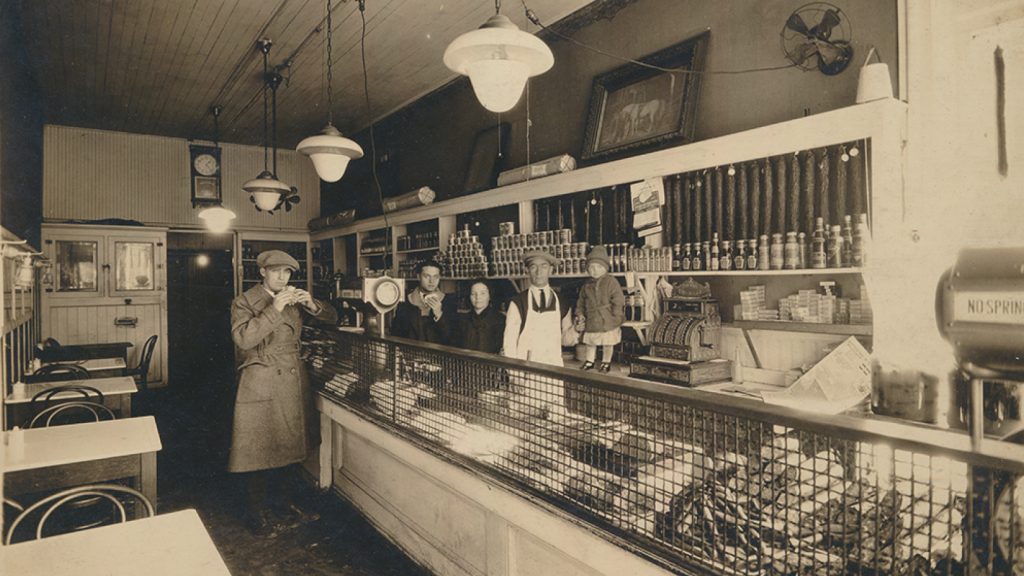The Metro: New exhibit tells history of Jewish community living in Detroit’s Black Bottom neighborhood
The Metro May 7, 2024Jewish Historical Society of Michigan and the Detroit Historical Museum present “In the Neighborhood: Everyday Life on Hastings Street,” about the Jewish enclave that used to exist in Black Bottom.

Schatzman and Handler Deli, 378 Hastings Street in Detroit.
Detroit’s Black Bottom community has received a lot of attention over the past year — in part because of the state of Michigan’s efforts to tear down I-375, which originally destroyed the neighborhood and displaced many Black residents and Black-owned businesses.
But while Black Detroiters bore a disproportionate brunt from the highways that destroyed Hastings Street, they weren’t the only people that were displaced from Black Bottom.
Jewish people have a long history in Detroit, and for them, a lot of it began in the late 1800s on Hastings Street.
Now, in tandem with the Jewish Historical Society of Michigan, the Detroit Historical Museum is running an exhibit called, “In the Neighborhood: Everyday Life on Hastings Street,” about the Jewish enclave that used to exist in Black Bottom before I-375 was created.
Jewish Historical Society of Michigan Executive Director Catherine Cangany joined The Metro to discuss the exhibit.
Subscribe to The Metro on Apple Podcasts, Spotify, NPR.org or wherever you get your podcasts.
Cangany explained that a big reason why the exhibit was created is the I-375 redevelopment project. The state, city and community are all thinking about how to address past harms when the freeway was built.
“Because the idea of repair is resonant — both in the Jewish and Black communities — we thought this would be a great time to not only bring that earlier chapter of the [historic] neighborhood back into conversation, but hopefully help push conversation forward into how to address the harm that was done in destroying these two incredibly vibrant communities,” Cangany said.
In the early 1900s, Detroit’s Black population grew from 41,000 to 120,000 — primarily living in Black Bottom and Paradise Valley, according to the DHS. Roughly 70,000 Eastern European Jews also called the community home.
“And it was much like where they had left in the Russian Empire,” Cangany stated. “Everything was within walking distance. They were together. They could speak Yiddish. They were Orthodox Jews. They kept kosher. So it was a way to preserve religion and cultural identity in a new space.”
The exhibit is on display through July 14.
More headlines from The Metro for May 7, 2024:
- In Southwest and parts of Detroit’s east side, auto and gas-powered plants have created poorer air quality for residents. A new remediation forest being constructed at East Canfield Art Park is hoping to alleviate environmental issues. The forest consists of air-purifying trees like pine and cypresses, space for community recreation, air quality monitors, and a large sculpture titled, “New Forest, Ancient Thrones.” Sidewalk Detroit Executive Director Ryan Myers Johnson and artist Jordan Weber join the show.
- Detroit Mayor Mike Duggan and other city officials celebrated the expungement of 10,000 conviction records Monday. That was due to a program called Project Clean Slate. It removed barriers for people with a criminal record to gain employment, housing, and access educational opportunities. WDET’s Bre’Anna Tinsley spoke with Nicholas Dubose who took part in Project Clean Slate.
- Our world is heating up, and one way to slow or stop that trend is by building homes and buildings that run on clean energy. This includes insulating structures and applying solar panels and heat pumps to them. Oregon Public Broadcasting’s Monica Samayoa reports on a tribal community in the state trying to do just that.
- Potential homeowners and renters in Michigan face no shortage of barriers in the quest for housing. Despite the amount of land they have access to, costs to both rent and own housing have increased substantially due to a lack of inventory. To discuss why these issues persist, including the challenges facing Detroiters, as well as potential solutions, design director Breck Crandell of architecture firm Three Squared, Inc. joins The Metro.
Trusted, accurate, up-to-date.
WDET strives to make our journalism accessible to everyone. As a public media institution, we maintain our journalistic integrity through independent support from readers like you. If you value WDET as your source of news, music and conversation, please make a gift today.
